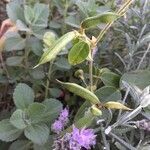Herbaceous vine, twining and scandent; stem filiform, 2-3 mm thick, hollow, pubescence uncinate, densely rufo-pilose, becoming less reddish, pilose hirsute to glabrous near the base, striate, infrequently branched, the internodes 7-16 cm. Leaves trifoliolate, oblong elliptic, occasionally ovate, the apex obtuse, retuse, mucronate, the base obtuse to rotund, 3.5-7(9) cm long, 1.5-5 cm wide, dark green and glabrous above, pale and densely pilose below, becoming scattered pilose with uncinate hairs on nerves, the veins weakly raised above, prominently raised below, primary nerves 7-9 pairs, alternate, obliquely ascending, secondary nerves reticulate; petiole 2.5-4 cm long, weakly 4-angled to terete, abruptly bent at the base forming an acute to right angle with the stem, pubescent; rachis 0.5-1.5(2.3) cm, similar to petiole; stipules persistent, broadly ovate, acute, striate, pubescence uncinate, sparsely pilose, ciliate, 3-5 mm long, 3-3.5 mm wide; sti-pels persistent, linear lanceolate, acute, striate, pubescent, 3-7 mm long, 0.5-1 mm wide, longer than petiolules, the terminal stipels slightly shorter than lateral stipels; petiolules 4-angled, 3-4 mm long, dark colored, pubescence uncinate, densely pilose. Inflorescence of axillary racemes, 2 or 4(6) flowered, bearing either chasmogamous or cleistogamous flowers, chasmogamous flowers with the peduncle subequal to longer than petiole and rachis, 5-13 cm, the pubescence pilose, uncinate; bracts 4, inner pair not seen, 3-5 mm long, 1.5 mm wide, lan-ceolate, striate, acuminate, pubescence uncinate, pilose ciliate, becoming re-flexed in age, outer pair usually narrower; pedicels 2-4(5) mm; bracteoles 7-12 mm long, 3-3.5 mm wide, lanceolate, striate, acuminate, pubescence uncinate, moderately pilose, ciliate, inserted 0.5-1 mm below the calyx; cleistogamous inflorescences with the peduncle 4-6.5 cm long, pilose and uncinate hairs; the bracts 3-3.5 mm long, 0.7-1.3 mm wide; the pedicels 2-3 mm; the bracteoles 6-7 mm long, 1.5-2 mm wide, inserted 0.5-1 mm below calyx. Chasmogamous flowers showy, lavender or white, sometimes becoming yellow with age; calyx tube 11-15 mm long, 4-7 mm wide at throat, pubescence uncinate, pilose, the lobes 9-13 mm long, ovate lanceolate, long acuminate, ciliate, 2-4 mm wide at base, the ventral lobe 12-14 mm long; standard 4-5 cm long, 3-4 cm wide, with sparse, appressed hairs denser along nerves and towards the margin, the apex ciliate, the wings extending beyond the keel 5-7 mm, the blade 14-17 mm long, 4-7 mm wide, the claw 9-13 mm long, the keel falcate, 7-9 mm across, 3-4 mm wide, the claw 16-18 mm; staminal column 20-27 mm long, incurved at tip, the free filaments 1-3 mm long, the anthers 1-1.2 mm long, 0.4-0.8 mm wide; ovary ca. 8 mm long, with dense white appressed, ascending hairs, the style 14-18 mm long, bearded, the stigma dilated; cleistogamous flowers inconspicuous, calyx tube 5-6 mm, 1.5 mm wide at the base to 2-3 mm wide at the throat, the lobes 5-7 mm long; corolla lacking. Fruit brown, slightly curved, biconvex, weakly compressed becoming subquadrangular, costate, 3-4.5(5) cm long, 8-9 mm wide, the pubescence uncinate and with few spreading hairs; stipe 8-9 mm long, en-closed in the calyx with the base of fruit; seeds cuboidal with rounded edges, a slight depression on the lateral faces, 4.5 mm long, 4 mm wide, brown, sticky, 5-8 per pod.
More
Herbs. Stems twining, ca. 2 mm thick, pubescent. Leaves imparipinnately 3-foliolate; stipules broadly ovate, 3-3.5 × ca. 2 mm, pubescent; petiole (1.5-)2-5 cm, pubescent; stipels persistent; petiolules 1-2.5 mm; leaflets oblong-elliptic to ovate, (1.8-)2-5.5(-7.5) × (0.8-)2.5-3.5 cm, abaxially pale green and densely pubescent, adaxially dark green and glabrous, lateral veins 6 or 7 pairs, base rounded, apex obtuse or slightly emarginate, mucronate. Inflorescence axillary, 1-4-flowered; peduncle 2-15 cm; bracts ca. 2 mm; bracteoles 7-17 mm. Flowers often cleistogamous. Calyx tube 3-4 mm; lobes narrowly lanceolate, 4-5 mm. Corolla often not developed [when present white, 3-4(-5) cm; standard very finely puberulent appearing glabrous; staminal sheath 20-40 mm]. Legume slightly curved, 3-4 × 0.8-1.1 cm, compressed, usually longitudinally ribbed, minutely puberulent, apex aristate. Seeds 4 or 5, dark reddish brown, ellipsoid to subglobose, ca. 3[-4] × 2 mm.

